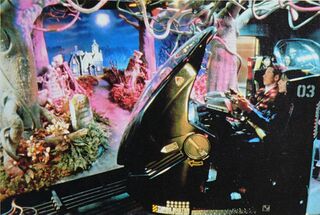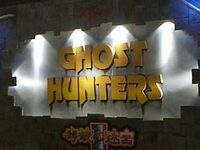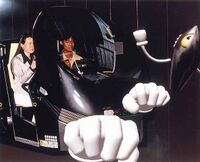Difference between revisions of "Ghost Hunters"
From Sega Retro
m (Undo revision 661317 by Ted618 (talk) Reverting changes due to inconsistent tense, removal of information, and I'd argue the sentence flows better and is more communicative in its original form) Tag: Undo |
(were still obvious grammar errors and incorrect details in the other version, fixed those and reinstated the extra info on the alternate versions - don't think they warrant their own pages, since it was basically the same attraction at its core anyway?) |
||
| Line 13: | Line 13: | ||
}} | }} | ||
| − | + | '''''{{PAGENAME}}''''' (ゴーストハンターズ) is a 3-minute long attraction designed by [[Sega]] for its amusement theme park venues in the mid-1990s. Combining the traditional [[wikipedia:Dark ride|dark ride]] attraction with elements of [[wikipedia:Augmented reality|augmented reality]] and light gun shooter gameplay, ''Ghost Hunters'' was operated at [[Joypolis]], [[Galbo]], and overseas [[Sega World]] locations. | |
==Story== | ==Story== | ||
| Line 19: | Line 19: | ||
==Gameplay== | ==Gameplay== | ||
| − | ''Ghost Hunters'' consists of sixteen two-seater ride vehicles which automatically travel on a track through | + | ''Ghost Hunters'' consists of sixteen two-seater ride vehicles which automatically travel on a track through a haunted house environment. On the front of each vehicle are two light guns and a large, concave perspex shield which acts as both a windshield and a mirror. As each car manoeuvres around the track, CGI ghosts and gun effects are projected onto the perspex screen and various parts of the attraction's scenery to create augmented reality illusions. |
| − | + | Players are tasked with using their guns to shoot the ghosts as quickly as possible, whilst travelling through horror-themed scenes. A mixture of digital and practical effects are used to strengthen immersion, including "breathing" walls and overhead air cannons which blow down onto riders. The amount and type of ghosts change depending on the players' performance. The "final boss" of the attraction is a creature named Gorgon; if defeated, a photo is taken of the player who dealt the final blow, and printed on a mock newspaper article given as a souvenir. Each ride cycle carries players around the circuit twice.{{ref|https://web.archive.org/web/19961224110309/http://www.sega.co.jp/sega/atp/atc/ghost.html}} | |
==History== | ==History== | ||
===Locations=== | ===Locations=== | ||
| − | ''Ghost Hunters'' made its public debut at [[Osaka ATC Galbo]], and | + | ''Ghost Hunters'' made its public debut at [[Osaka ATC Galbo]] in April 1994, and would feature at eight other indoor theme park venues created by Sega. |
| + | * [[Osaka ATC Galbo]] | ||
* [[Yokohama Joypolis]] | * [[Yokohama Joypolis]] | ||
* [[Ichikawa Galbo]] | * [[Ichikawa Galbo]] | ||
| Line 36: | Line 37: | ||
* [[Sega World Sydney]] | * [[Sega World Sydney]] | ||
| − | The only | + | One of these is known to have been moved to Yokohama Dreamland in 1999, and was abandoned alongside the park after its permanent closure in 2002.{{ref|http://www2.ttcn.ne.jp/hexplorer/gsh/ydlghs.htm}} Another was relocated to be housed in the first Neo Geo theme park, Neo Geo World Tsukuba, opened by [[SNK]] in December 1995.{{ref|https://www.culturaneogeo.com/neogeoworld}} The only version to remain in operation is the former [[Sega World Sydney]] model, purchased by Indian resort [https://www.haailand.in/ Haiiland] after the venue’s closure.{{ref|https://www.haailand.in/pages/rides.html}} |
| + | |||
| + | ===Versions=== | ||
| + | ====Ghost Hunters II==== | ||
| + | [[File:GhostHuntersII_Yokohama.jpg|thumbnail|200px]] | ||
| + | After ''Ghost Hunters'' made its debut at Osaka ATC Galbo in April 1994, an updated version officially referred to as ''Ghost Hunters II ~ The Labyrinth of Poisonous Moths ~'' (ゴーストハンターズП~毒蛾の迷宮~) was installed at the venue and Yokohama Joypolis on 11 September 1995 as part of a renewal of their attractions,{{ref|https://web.archive.org/web/19961224110309/http://www.sega.co.jp/sega/atp/atc/ghost.html}} with most subsequent locations also receiving the update thereafter. Ride facades in many of the parks still called the attraction ''Ghost Hunters'', and changes made to it largely altered its theming.{{ref|https://web.archive.org/web/19961224110309/http://www.sega.co.jp/sega/atp/atc/ghost.html}} | ||
| + | |||
| + | ====Treasure Panic==== | ||
| + | [[File:TreasurePanic_Tokyo.jpg|thumbnail|200px|''Treasure Panic'' in Tokyo Joypolis]] | ||
| + | A redeveloped version of the attraction, ''Treasure Panic'' (トレジャーパニック), was debuted at [[Tokyo Joypolis]] on the centre's opening day in July 1996.{{ref|https://web.archive.org/web/19961224110200/http://www.sega.co.jp/sega/atp/tokyo/panic.html}} Though the physical attraction itself remains the much the same in this incarnation, with the exception of the additions of a branching path and different theming, its revised gameplay concept revolves around submerged treasure on a sunken pirate ship; players' guns instead act as triggers for large gloves used to hit and grab opponents. ''Treasure Panic'' is not thought to have been installed at any other venues, and was later removed from Tokyo Joypolis in late 1999. | ||
==Promotional material== | ==Promotional material== | ||
Revision as of 23:22, 28 March 2021

| |||||
| Ghost Hunters | |||||
|---|---|---|---|---|---|
| System(s): Medium-scale attraction | |||||
| Publisher: Sega | |||||
| Developer: Sega AM5 | |||||
| Genre: Action | |||||
| Number of players: 32 | |||||
|
Ghost Hunters (ゴーストハンターズ) is a 3-minute long attraction designed by Sega for its amusement theme park venues in the mid-1990s. Combining the traditional dark ride attraction with elements of augmented reality and light gun shooter gameplay, Ghost Hunters was operated at Joypolis, Galbo, and overseas Sega World locations.
Contents
Story
Players are volunteer "Ghost Hunters" at the Institute for Spirit Extermination. Director Harold and his assistant Jennifer welcome the players for routine training, when an emergency suddenly occurs: the Arthur family's home on 7th Avenue is overrun with ghosts. Players mount one of sixteen "Turbo Buster" ride vehicles, which are equipped with a special spiritual barrier and autopilot, and use their "blaster beams" to rid the house of its ghost infestation.
Gameplay
Ghost Hunters consists of sixteen two-seater ride vehicles which automatically travel on a track through a haunted house environment. On the front of each vehicle are two light guns and a large, concave perspex shield which acts as both a windshield and a mirror. As each car manoeuvres around the track, CGI ghosts and gun effects are projected onto the perspex screen and various parts of the attraction's scenery to create augmented reality illusions.
Players are tasked with using their guns to shoot the ghosts as quickly as possible, whilst travelling through horror-themed scenes. A mixture of digital and practical effects are used to strengthen immersion, including "breathing" walls and overhead air cannons which blow down onto riders. The amount and type of ghosts change depending on the players' performance. The "final boss" of the attraction is a creature named Gorgon; if defeated, a photo is taken of the player who dealt the final blow, and printed on a mock newspaper article given as a souvenir. Each ride cycle carries players around the circuit twice.[1]
History
Locations
Ghost Hunters made its public debut at Osaka ATC Galbo in April 1994, and would feature at eight other indoor theme park venues created by Sega.
- Osaka ATC Galbo
- Yokohama Joypolis
- Ichikawa Galbo
- Yokkaichi Galbo
- Niigata Joypolis
- Fukuoka Joypolis
- SegaWorld London
- Shinjuku Joypolis
- Sega World Sydney
One of these is known to have been moved to Yokohama Dreamland in 1999, and was abandoned alongside the park after its permanent closure in 2002.[2] Another was relocated to be housed in the first Neo Geo theme park, Neo Geo World Tsukuba, opened by SNK in December 1995.[3] The only version to remain in operation is the former Sega World Sydney model, purchased by Indian resort Haiiland after the venue’s closure.[4]
Versions
Ghost Hunters II
After Ghost Hunters made its debut at Osaka ATC Galbo in April 1994, an updated version officially referred to as Ghost Hunters II ~ The Labyrinth of Poisonous Moths ~ (ゴーストハンターズП~毒蛾の迷宮~) was installed at the venue and Yokohama Joypolis on 11 September 1995 as part of a renewal of their attractions,[1] with most subsequent locations also receiving the update thereafter. Ride facades in many of the parks still called the attraction Ghost Hunters, and changes made to it largely altered its theming.[1]
Treasure Panic
A redeveloped version of the attraction, Treasure Panic (トレジャーパニック), was debuted at Tokyo Joypolis on the centre's opening day in July 1996.[5] Though the physical attraction itself remains the much the same in this incarnation, with the exception of the additions of a branching path and different theming, its revised gameplay concept revolves around submerged treasure on a sunken pirate ship; players' guns instead act as triggers for large gloves used to hit and grab opponents. Treasure Panic is not thought to have been installed at any other venues, and was later removed from Tokyo Joypolis in late 1999.
Promotional material
Artwork
References
- ↑ 1.0 1.1 1.2 http://www.sega.co.jp/sega/atp/atc/ghost.html (Wayback Machine: 1996-12-24 11:03)
- ↑ http://www2.ttcn.ne.jp/hexplorer/gsh/ydlghs.htm
- ↑ https://www.culturaneogeo.com/neogeoworld
- ↑ https://www.haailand.in/pages/rides.html
- ↑ http://www.sega.co.jp/sega/atp/tokyo/panic.html (Wayback Machine: 1996-12-24 11:02)



